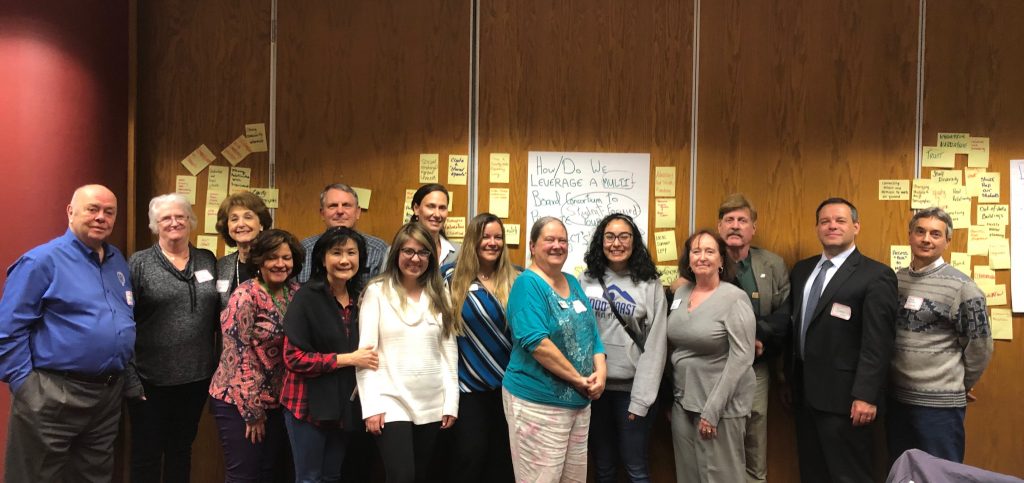EAST COUNTY SCHOOL B0ARDS CONNECT

“I think the thread that binds us together is much stronger than what differentiates us in our respective organizations,” said Tamie Arnold, MHCC District board member, at the beginning of an unusual meeting of MHCC Board and representatives from several K-12 school boards within Mt. Hood’s district.
A total of 15 representatives gathered April 8 in MHCC’s Town & Gown room, on behalf of the Centennial, Corbett, Gresham-Barlow, and Reynolds school districts, MESD (Multnomah Education Service District), and MHCC. Participants included board members and superintendents, plus MHCC President Lisa Skari.
Missing were board members from the David Douglas, Parkrose, and Oregon Trail (Sandy) school districts, whom many in attendance wished had been able to attend.
This special meeting of the boards was Arnold’s idea. She often found herself wondering why most East County school board members don’t know each other, and saw room for improved collaboration. She thought it was important to get to know board members in other districts to increase communication between them, she said.
“East County needs us to be together and to work together,” said Arnold.
Starting with a problem solving icebreaker exercise to get each table group working together, event facilitator Paul Wild, an MHCC employee focused on professional development and continuous improvement, had each board member think of their own panel’s strengths and challenges.
Strengths listed in response included: loyal staff, leadership, equity, financial health, passing a (voter-approved) bond measure, having active programs and engaged students, and having strong CTE (Career Technical Education) programs.
Challenges shared included: budget shortfalls, struggling to pass a bond, poor community relations, need for facility and system improvement plans, and a lack of a staff (teachers and others) that is diverse, and representative of students.
MONEY TALK
At first, Wild lumped “budget” and “bond” into one category, but then Arnold said she felt they were separate because passage of a bond measure is community centered, and the district’s budgets are state-funded.
John Hartsock, a board member from Gresham/Barlow, suggested that school districts look further into more local funding options. He said it’s about getting the community to trust that the bond is truly important. Since around 70 percent of people in school districts don’t have children in the schools, they’re the group that most needs to be persuaded to support bonds, he said.
Mary Botkin, an MESD board member, added that every biennium (two-year state budget cycle), parents feel like they’re giving more money to schools and not seeing any change, so the community needs to be shown that schools are actually doing good.
“They trust (news) headlines and they don’t trust us,” said Kris Howatt, Gresham/Barlow board member about the voter skepticism. “They trust the headlines more than what we tell them.”
WORKING TOGETHER
Wild had the group discuss how districts could leverage a multi-board consortium to promote their districts’ needs.
Some of the ideas brought up: having a shared agenda, business collaborations, media outreach, legislative advocacy, dual credits classes, learn from the expertise of other board members in certain areas, and advocate for more direct public transportation to MHCC.
Another idea raised: a “P-20” system. It was originally discussed a K-14 or K-16 system – including two or four years beyond high school – but Jessica Arzate, MESD board member, explained that preschools and community colleges are both underfunded, so the P-20 system (preschool through master’s degree studies) would capture all institutions.
Focusing on ways the various school boards can team up more effectively, Rod Boettcher, Centennial board member, said that in the past some of the East County K-12 districts have met up for months, but lacked a strong focus or agenda and so momentum dissipated.
Pam Shields, Centennial board chair, suggested that the panels focus on what links them, which is that they have shared students. She also noted how often the only communication between districts is between presidents and superintendents, and so there haven’t been strong contacts over time. She suggested that boards should stay student-focused, and if one board has solved a problem, it could share that path to success with other boards.
Other ideas listed included coordinating school start and end times across school districts for K-12 and having MHCC classes available after high schools get out for the day, for students wanting to take a course.
Another time coordination issue included scheduling of board meetings: It was hard for many participants to make it to this meeting, in particular, because they’re used to planning their lives months in advance around their own board meetings. Moving forward, the boards will try to share their meeting schedules to try to ensure there isn’t one board or another having a meeting every day of the week, to prevent all the boards from being able to gather on a certain day if they so choose.
Overall, everyone seemed interested in meeting and collaborating again, but next time with more advance notice and with all East County school districts present.
Arnold said afterward, “There was a lot of energy, a lot of friendly faces, a lot of good information being shared, and I’m really optimistic about our opportunities for collaborating in the future.”

Leave a comment